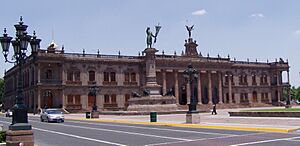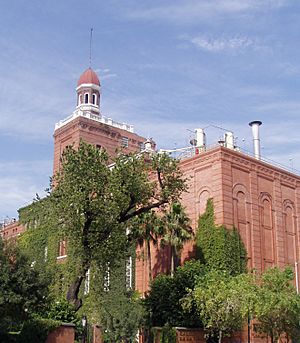Nuevo León facts for kids
Quick facts for kids
Nuevo León Semper
Estado Libre y Soberano de Nuevo León
|
||
|---|---|---|
|
State of Mexico
|
||
| Free and Sovereign State of Nuevo León | ||
|
||
| Motto(s):
Semper Ascendens
(Always Ascending)
|
||
| Anthem: Himno de Nuevo León | ||
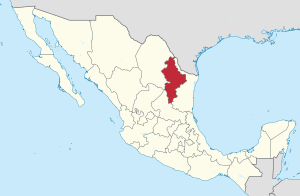
State of Nuevo León within Mexico
|
||
| Country | Mexico | |
| Capital | Monterrey | |
| Largest City | Monterrey | |
| Largest Metropolitan Area | Greater Monterrey | |
| Became a state | May 7, 1824 | |
| Order | 15th | |
| Area | ||
| • Total | 64,156 km2 (24,771 sq mi) | |
| Ranked 13th | ||
| Highest elevation | 3,710 m (12,170 ft) | |
| Population
(2015)
|
||
| • Total | 5,119,504 | |
| • Rank | 8th | |
| • Density | 79.7977/km2 (206.6752/sq mi) | |
| • Density rank | 14th | |
| Demonym(s) | Neoleonés | |
| Time zone | UTC−6 (CST) | |
| • Summer (DST) | UTC−5 (CDT) | |
| Postal code |
64–67
|
|
| Area code |
Area codes
|
|
| ISO 3166 code | MX-NLE | |
| HDI | ||
| GDP | US$ 132,655 mil | |
| per capita | US$ 28,509.00 | |
Nuevo León is one of the 31 states in Mexico. It is located in the northeastern part of the country. With Mexico City, these make up the 32 Federal Entities of Mexico. The state is divided into 51 areas called municipalities. Its capital city is Monterrey.
Nuevo León shares borders with other Mexican states: Tamaulipas to the north and east, San Luis Potosí to the south, and Coahuila to the west. It also has a short 15-kilometer (9-mile) border with the U.S. state of Texas in the United States.
The state got its name from the "New Kingdom of León." This was an old administrative area of New Spain, which was named after the historic Spanish Kingdom of León.
Besides its capital, other important cities in Nuevo León include Guadalupe, Santa Catarina, San Nicolás de los Garza, and San Pedro Garza García. All these cities are part of the larger Monterrey Metropolitan area.
Contents
History of Nuevo León
Nuevo León was first explored by a Spanish leader named Alberto del Canto. However, it was hard to build lasting towns because of frequent attacks by the Chichimeca people, who were the native groups of the north.
After del Canto's attempts failed, Luis de Carvajal y de la Cueva tried to settle the area. He led a group of Portuguese and Spanish settlers, some of whom were of Jewish background. They asked the Spanish King for permission to create a new area called the New Kingdom of León, but this attempt also didn't last.
It wasn't until 1596, under the leadership of Diego de Montemayor, that a permanent colony was finally established. Over time, Nuevo León became one of the Eastern Internal Provinces in Northern New Spain, along with Coahuila, Nuevo Santander, and Texas.
Today, the capital of Nuevo León is Monterrey. It is the third-largest city in Mexico, with more than four million people living there. Monterrey is a modern and wealthy city. Nuevo León has been one of Mexico's most industrialized states for a long time.
Geography and Climate
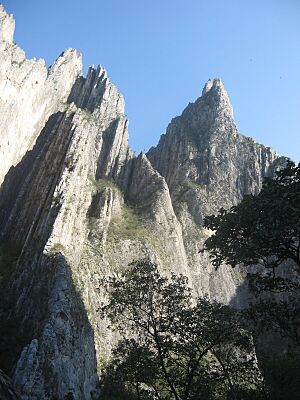
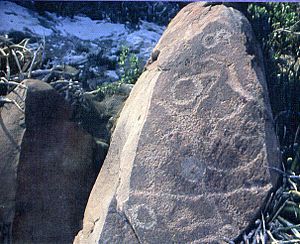
Nuevo León has a very varied climate, and some parts get very little rain all year. The state covers about 64,220 square kilometers (24,795 square miles). It can be divided into three main climate regions:
- A hot, dry region in the north.
- A milder, temperate region in the mountains.
- A semi-dry region in the south.
The Sierra Madre Oriental mountain range greatly shapes the land. It forms high plains like the Galeana and Doctor Arroyo plateaus. It also creates mountain ranges such as Iguana, Picachos, Papagayos, and Santa Clara, as well as valleys like Pilón, Ascensión, and Río Blanco.
For water, the San Juan River feeds the El Cuchillo dam. This dam provides water for Monterrey and the surrounding cities. Other important dams include Cerro Prieto, La Boca, Vaquerías, Nogalitos, and Agualeguas. Laguna de Labradores is a large lake, and Pozo del Gavilán is a natural well. Both are found in the Galeana municipality.
In the northern part of the state, the climate is very dry because it is close to the Chihuahuan Desert. Temperatures can reach 47°C (117°F) or more in the desert areas, while winters are short and mild. In Monterrey, the climate is hot and semi-dry, with very hot summers and mild winters. It usually gets about 500 mm (20 inches) or less of rain each year.
People and Education
As of 2015, Nuevo León had about 5.119 million people. More than 90% of them, about 4.7 million, live in the Monterrey Metropolitan area. This makes it the third-largest metropolitan area in Mexico. People in Nuevo León tend to live long lives: 73 years for men and 79 years for women.
Most of the population (94%) lives in cities. About one million families own their homes, and 98% of homes have important services like running water, sewer systems, and electricity. The remaining 2% is mostly made up of small groups of native people who live in isolated mountain areas.
Like the rest of Mexico, most people in Nuevo León are Roman Catholic. However, there is also a good number of Protestants living in the state.
The high quality of life in Nuevo León can be seen in its education levels. The state has an almost perfect record for students finishing secondary education. Also, 13 out of every 100 people earn a professional degree.
Economy of Nuevo León
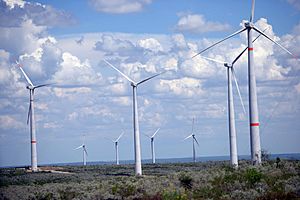
Nuevo León is a highly industrialized state. This means it has many factories and businesses. Its standard of living is similar to that of countries like Croatia, Slovakia, or Poland.
Nuevo León also has a rich farming area known as the "orange belt." This area includes the municipalities of Allende, Montemorelos, Hualahuises, General Terán, and Linares. Farmers here traditionally grew oranges and cereals. Now, small but smart investments are turning these farms into modern agro-industrial businesses. This means they process farm products into other goods, which brings more money to the local economy.
However, most of the southern part of the state has very dry weather. This makes farming and raising animals very difficult there.
In recent years, the state government has been working hard to attract new businesses. They are especially interested in areas like aeronautics (making airplanes), biotechnology (using living things to make products), mechatronics (combining mechanics and electronics), and information and communication technologies. To support this, they created the Research and Technology Innovation Park (PIIT). This park focuses on developing new ideas and research in science. This project is a key part of the "Monterrey, City of Knowledge" program.
Municipalities
Nuevo León is divided into 51 municipalities (municipios).
Largest Cities
| City | City Population |
Metropolitan Population |
Metropolitan area type |
|---|---|---|---|
| Monterrey | 1,135,550 | 4,570,577 | Municipality |
| Guadalupe | 678,006 | Part of Greater Monterrey | |
| Apodaca | 523,270 | ||
| San Nicolás de los Garza | 443,273 | ||
| General Escobedo | 357,256 | ||
| Santa Catarina | 270,790 | ||
| Juarez | 256,454 | ||
| García | 143,668 | ||
| San Pedro Garza García | 119,017 |
Animals and Plants of Nuevo León
Nuevo León is home to many different animals and plants. Here are some examples:
-
A Kit fox (Vulpes macrotis).
-
An American Black Bear (Ursus americanus).
-
A Northern Cardinal (Cardinalis cardinalis).
-
A Hooded skunk (Mephitis macroura).
-
A Golden eagle (Aquila chrysaetos).
-
A Steller's jay (Cyanocitta stelleri).
-
A Collared peccary (Pecari tajacu).
-
A Least Grebe (Tachybaptus dominicus).
-
A Pronghorn (Antilocapra americana).
-
A Pecan tree (Carya illinoinensis).
-
A Chestnut dioon plant (Dioon edule).
-
An Eastern redbud tree (Cercis canadensis).
Partnerships and Agreements
The state of Nuevo León has special agreements with other states, provinces, regions, and communities around the world. These partnerships help with trade, culture, and other shared interests.
- British Columbia, Canada
- Quebec, Canada
- Texas, United States
- Catalonia, Spain
- Lombardy, Italy
- State of Mexico, Mexico
- Jalisco, Mexico
- Coahuila, Mexico
See also
 In Spanish: Nuevo León para niños
In Spanish: Nuevo León para niños



